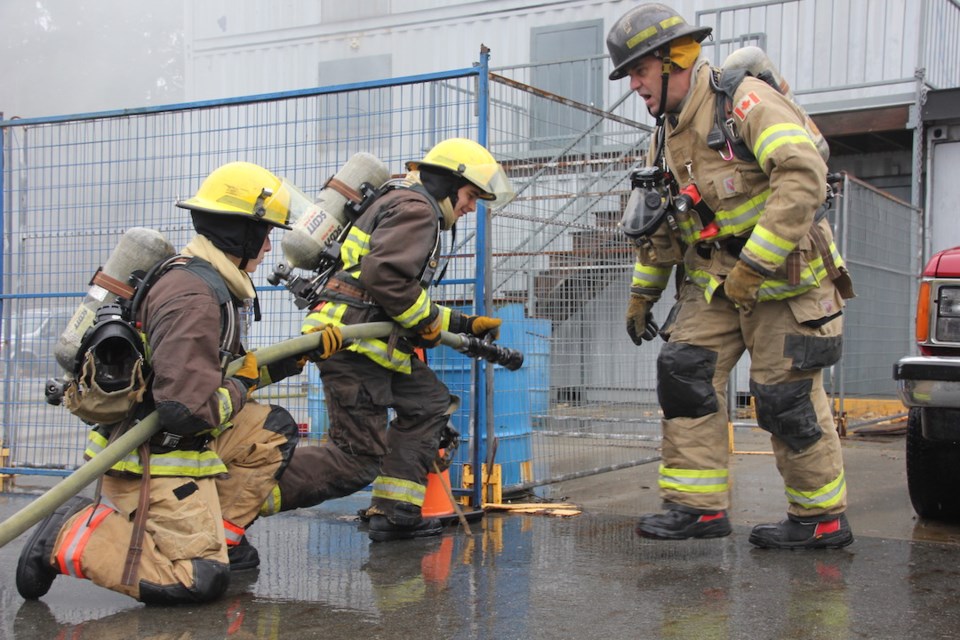On an overcast spring day, smoke billowed out of a four-storey tower on Mason Road in Sechelt.
Inside – where the heat felt like the inside of an oven – a group of teens learned what fire looks like as it ignites and the flames roll overhead. While the fire was real, the situation was very much under control with the expertise of the Sechelt Fire Department and other local first responders.
Between March 12 and 19, the Sunshine Coast School District No. 46 (SD46) held its first-ever junior firefighter academy. Ten students from Grades 11 and 12 were selected to spend the entirety of spring break learning the basics of firefighting firsthand (and earning work experience credits along the way).
As the teens emerged from the building and removed their safety equipment, they were sweating and smiling.
For 17-year-old Elijah Karkabe, it may have been one of his favourite days in the program. The Grade 12 Chatelech student plans to take a gap year before pursuing a career in firefighting through the Justice Institute of British Columbia. He likes hands-on work, is particularly interested in structure fires, and – most of all – wants to help others. In the fall, Karkabe plans to apply to volunteer with the Gibsons & District Volunteer Fire Department. He hopes this experience will give him a head start for the recruitment process.
He said he may have been the first to sign up for the academy, after SD46 career coordinator Cathy Gordon told him about the idea.
“I was excited from day one. I was looking forward to it as soon as she told me that it could happen,” Karkabe said.
In 2021, SD46 announced the application period for the program to Grade 11 and 12 students in all parts of the lower Coast. Gordon says the program helps the students acquire leadership, volunteering and mentoring skills.
“We had discussed doing an academy here on the Coast for a number of years,” Sechelt Fire Department’s assistant fire chief Dwight Davison said. When Gordon approached the department about starting a program for students, “she had that missing piece we were lacking.”
What it takes
First, the students had to be accepted. They submitted written applications, and had to pass a fitness test including a two-kilometre run, at least 20 push-ups in a minute, and at least 40 sit-ups in a minute. If they passed, they were interviewed by members of the fire departments and selected.
For five days, the 10 students learned what it takes to be a community firefighter, from operating the jaws of life, the safety equipment, finding trapped people, to putting out a fire. They also learned about the history of fire departments in North America and studied the science behind fire behaviour.
Safety equipment was borrowed from Vancouver Fire and Rescue Services, and 21 local firefighters (17 from Sechelt and four from Gibsons) helped with the training, Davison said, bringing together a combined 329 years of fire service. Davison said he hopes some of that knowledge, like using and keeping fire extinguishers at home, is shared with the students’ families.
“They’re peak athletes,” Karkabe said of the firefighters. “It’s a lot more work than they make it look like. So that was an eye opener for me, just to realize how much they physically do.” He said his shoulders were sore after wearing the heavy equipment, but that got easier over time.
“The students definitely exceeded our expectations,” Davison said. “By the end of day four and five, we had to make some things challenging for them.”
Wildfire awareness
The last three days of the program were dedicated to forestry firefighting, which includes different techniques, since they often don’t have access to the same water sources. Sometimes wildfire firefighters will have to pull water from helicopters or creeks – if they use water at all. The students also learned how to dig trenches when water is not available.
Stephen Gemmell, a wildfire technician for the Sunshine Coast fire zone, said they prepared a “week in the life” of day-to-day duties, including theory, drills and a wildfire scenario in the bush. Gemmell said he’d like to have even more time with students to complete more certification.
“It’s about reaching that next generation of first responders, whether that be wildfires, structural fire, or any kind of emergency service really,” Gemmell said. He’s trying to raise “awareness that this is a satisfying line of work and mentally, physically stimulating and challenging” – and recruit where he can. “If I can get jobs to local people, that’s a huge win.”
The next generation
Several of the students said they would be interested in a job or volunteering as a firefighter, Davison said. Two students may be offered summer jobs with BC Wildfire, and Gemmell said he’d love to help all the participating students interested in pursuing wildfire as a career.
“It’s definitely one of the better ways I’ve spent my spring break,” Karkabe said, adding that he would definitely recommend it to other students.
On March 26, the junior firefighters will put out a car fire in front of their invited families as a demonstration of their new skills. Once they wow the crowd, an award ceremony will take place.
As for the future of the program, Davison said, “As long as the school district supports it, we can make this happen.”






